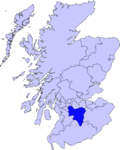History
The school originated in a primary school run by the Sisters of Notre Dame since 1953, which in 1971 was announced for closure. [1] A committee of parents was formed to keep the school open, and in August 1972 the current school opened. There were at the time four members of staff, with the committee serving as the Board of Governors, and the headmistress was Sister Gabriel, of the Sisters of St. Joseph of Cluny. At this time, the school was still only a primary school, and in 1973 it was decided to open a secondary department. [1]
The school stands in some 9 acres (36,000 m2) of wooded grounds above the city of Glasgow, backing on to the Cathkin Braes. [2] The total Nursery roll has been around 20, the Primary roll has been around 120 and the Secondary has been around 110. [2] Plans were announced in 2013 to make the secondary department co-educational. Fees for S3 - S6 have been £12,600 per annum, [3] making it the 20th-most expensive school in Scotland.
It was reported in a front-page article in The Herald on 11 June 2014 that the school had called in the administrators after suffering financial difficulties. Later that day, the school released a statement to say that funds had been secured from parents and governors to allow the school to remain open while refinancing was undertaken. [4] [5]
This page is based on this
Wikipedia article Text is available under the
CC BY-SA 4.0 license; additional terms may apply.
Images, videos and audio are available under their respective licenses.



